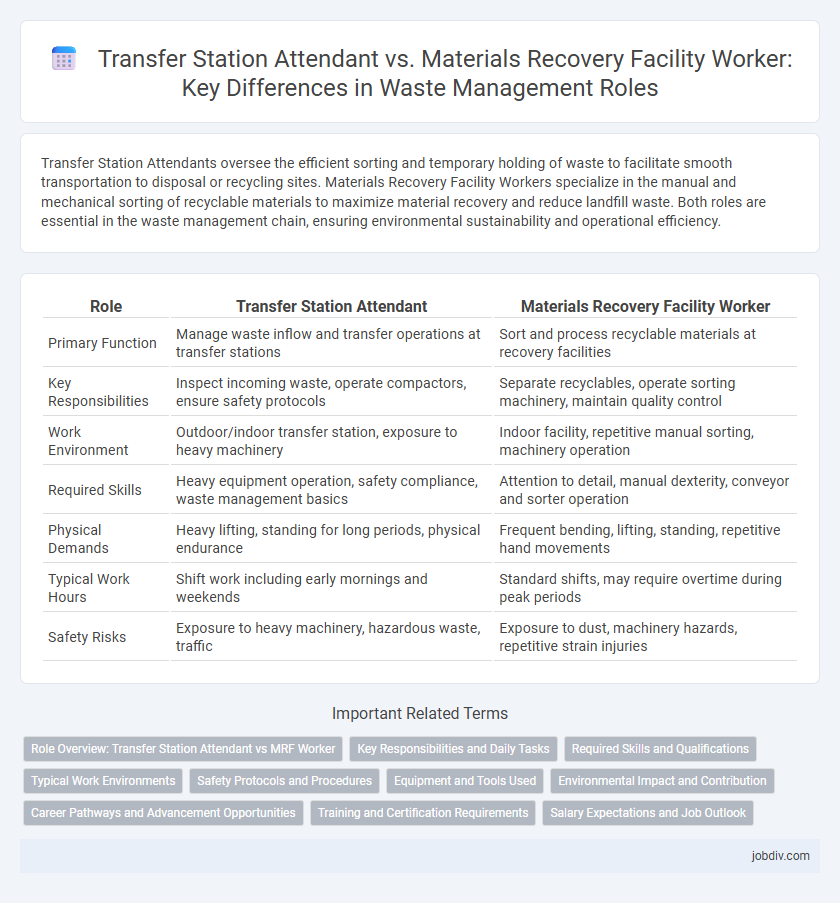Transfer Station Attendants oversee the efficient sorting and temporary holding of waste to facilitate smooth transportation to disposal or recycling sites. Materials Recovery Facility Workers specialize in the manual and mechanical sorting of recyclable materials to maximize material recovery and reduce landfill waste. Both roles are essential in the waste management chain, ensuring environmental sustainability and operational efficiency.
Table of Comparison
| Role | Transfer Station Attendant | Materials Recovery Facility Worker |
|---|---|---|
| Primary Function | Manage waste inflow and transfer operations at transfer stations | Sort and process recyclable materials at recovery facilities |
| Key Responsibilities | Inspect incoming waste, operate compactors, ensure safety protocols | Separate recyclables, operate sorting machinery, maintain quality control |
| Work Environment | Outdoor/indoor transfer station, exposure to heavy machinery | Indoor facility, repetitive manual sorting, machinery operation |
| Required Skills | Heavy equipment operation, safety compliance, waste management basics | Attention to detail, manual dexterity, conveyor and sorter operation |
| Physical Demands | Heavy lifting, standing for long periods, physical endurance | Frequent bending, lifting, standing, repetitive hand movements |
| Typical Work Hours | Shift work including early mornings and weekends | Standard shifts, may require overtime during peak periods |
| Safety Risks | Exposure to heavy machinery, hazardous waste, traffic | Exposure to dust, machinery hazards, repetitive strain injuries |
Role Overview: Transfer Station Attendant vs MRF Worker
Transfer Station Attendants manage the intake, sorting, and temporary storage of waste at transfer stations, ensuring efficient material flow and regulatory compliance. Materials Recovery Facility (MRF) Workers operate complex sorting systems to separate recyclables from waste streams, enhancing material recovery rates. Both roles contribute to waste management but differ in operational settings and technical tasks.
Key Responsibilities and Daily Tasks
Transfer Station Attendants manage the receipt, sorting, and temporary storage of incoming waste and recyclables, ensuring compliance with environmental regulations and proper documentation. Materials Recovery Facility Workers operate machinery to sort, separate, and process recyclables, optimizing material recovery rates through manual and automated systems. Both roles require adherence to safety protocols, but Materials Recovery Facility Workers focus more on sorting efficiency and quality control, while Transfer Station Attendants emphasize logistics and waste flow management.
Required Skills and Qualifications
Transfer Station Attendants require skills in equipment operation, waste sorting, and adherence to safety protocols, with a high school diploma typically sufficient for entry. Materials Recovery Facility Workers need strong knowledge of recyclable material categories, proficiency in manual and automated sorting processes, and compliance with environmental regulations, often benefiting from vocational training. Both roles demand physical stamina, attention to detail, and effective communication abilities to maintain efficient waste management operations.
Typical Work Environments
Transfer Station Attendants typically work in outdoor or semi-enclosed environments where waste is temporarily held before transportation to disposal or recycling centers. Materials Recovery Facility Workers operate in indoor sorting facilities equipped with conveyor belts, machinery, and safety equipment designed to separate recyclable materials from waste streams. Both roles require adherence to safety protocols, but the Materials Recovery Facility environment is generally more controlled and mechanized compared to the often variable conditions at transfer stations.
Safety Protocols and Procedures
Transfer Station Attendants enforce strict safety protocols including proper handling of heavy machinery and hazardous waste to prevent accidents during waste sorting and transfer. Materials Recovery Facility Workers follow detailed safety procedures involving personal protective equipment (PPE), contamination prevention, and equipment operation to ensure safe separation and processing of recyclables. Both roles require adherence to OSHA standards and regular safety training to minimize workplace hazards and promote efficient waste management.
Equipment and Tools Used
Transfer station attendants primarily operate heavy machinery such as compactors, front-end loaders, and forklifts to efficiently manage waste sorting and volume reduction. Materials recovery facility workers utilize advanced conveyor systems, sorting robots, magnetic separators, and optical sorters to accurately separate recyclable materials from mixed waste streams. Both roles require the use of personal protective equipment (PPE) including gloves, safety goggles, and high-visibility clothing to ensure safety in hazardous environments.
Environmental Impact and Contribution
Transfer Station Attendants play a crucial role in organizing and temporarily storing waste, preventing illegal dumping, and ensuring proper sorting to reduce landfill overflow, which minimizes environmental contamination. Materials Recovery Facility Workers specialize in sorting recyclable materials, significantly increasing recycling rates and conserving natural resources by diverting waste from landfills and reducing greenhouse gas emissions. Both positions contribute to sustainable waste management, with Transfer Station Attendants focusing on waste control logistics and Materials Recovery Facility Workers advancing material recovery and recycling efficiency.
Career Pathways and Advancement Opportunities
Transfer Station Attendants primarily handle the sorting and temporary storage of waste, offering entry-level opportunities with potential advancement into supervisory roles or specialized equipment operation. Materials Recovery Facility (MRF) Workers focus on separating recyclable materials, providing career growth through technical training in machinery maintenance and quality control management. Both career pathways emphasize skill development, with MRF roles often leading to higher earning potential due to increased technical expertise.
Training and Certification Requirements
Transfer Station Attendants generally require basic safety training, hazardous materials awareness, and operation of weighing scales, often secured through on-the-job training or short certification courses. Materials Recovery Facility Workers must complete more specialized training including sort line operation, equipment handling certifications, and knowledge of recyclable material standards, frequently supported by OSHA safety certifications and waste management courses. Employers may prioritize candidates with vocational training in waste management or environmental science to meet compliance and operational efficiency goals.
Salary Expectations and Job Outlook
Transfer Station Attendants typically earn an average salary ranging from $30,000 to $45,000 annually, with a steady job outlook driven by municipal waste management needs. Materials Recovery Facility (MRF) Workers often see salaries between $28,000 and $42,000, benefiting from increasing demand for recycling services and sustainable waste processing. Both roles show consistent employment opportunities, but MRF Workers may experience slightly higher growth due to expanding recycling programs and environmental regulations.
Transfer Station Attendant vs Materials Recovery Facility Worker Infographic

 jobdiv.com
jobdiv.com